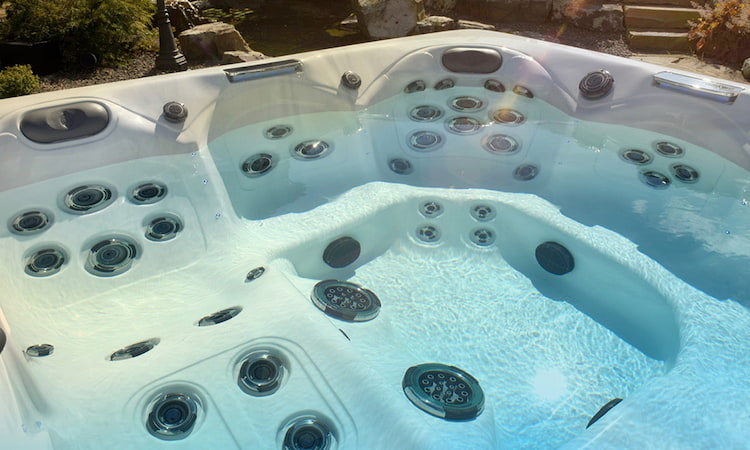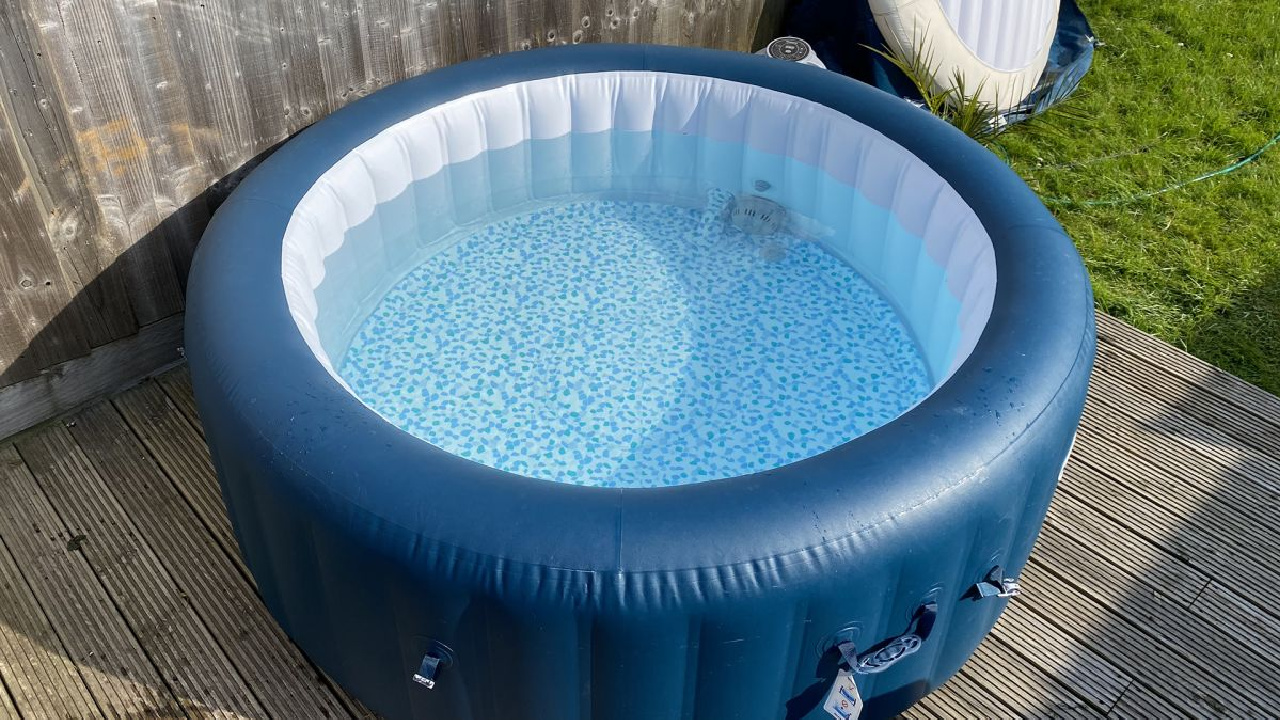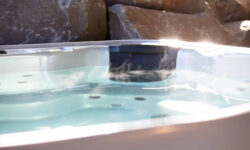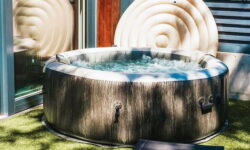You’re ready for a relaxing soak, but your hot tub’s acting up, dropping the temperature unexpectedly. Don’t let it dampen your spirits! Understanding the basics of your hot tub’s heating system, potential problems, and the role of insulation can help.
Your hot tub might be dropping temperature due to several reasons. One possibility could be that the heater is malfunctioning or not powerful enough to maintain the required temperature, especially in colder weather. It might also be due to a faulty thermostat, which is not detecting and maintaining the correct temperature. Another common reason could be a leak in the hot tub, causing hot water to escape and thus reducing the overall temperature.
We’ll also explore external factors that could be affecting your tub’s temperature. Stick around for useful solutions and maintenance tips to get your hot tub back in optimal shape.

Quick Navigation
- Understanding the Basics of Hot Tub Heating Systems
- Identifying Common Problems With Hot Tub Heaters
- The Role of Insulation in Maintaining Hot Tub Temperature
- Possible External Factors Affecting Your Hot Tub’s Temperature
- Solutions and Maintenance Tips for Hot Tub Temperature Issues
- Frequently Asked Questions
- Conclusion
Understanding the Basics of Hot Tub Heating Systems
To grasp the concept of why your hot tub’s temperature might be falling, you’ll first need to understand the basics of hot tub heating systems. Fundamentally, your hot tub utilizes a heating system that’s a blend of mechanical and electrical components working in harmony.
Your heating system primarily consists of a heater, thermostat, high-limit switch, and a pump. The pump circulates the water, while the heater, controlled by your thermostat, raises the water’s temperature. The high limit switch, a critical safety feature, prevents overheating.
Imagine it like a well-choreographed dance. The thermostat signals the heater to start warming the water. The pump circulates this heated water, ensuring even distribution. The high-limit switch oversees the performance, ready to shut things down if the water gets too hot.
If any part of this system falters, your hot tub’s temperature can drop. A malfunctioning thermostat might not signal the heater correctly, a failing pump might not circulate the water efficiently, or a tripped high-limit switch might shut down the heater prematurely.
Now that you’ve got the basics down, you’re ready to dive deeper into understanding why your hot tub’s temperature might be falling.
Identifying Common Problems With Hot Tub Heaters
You’ve got a solid understanding of how your hot tub’s heating system works, and now you’re ready to identify some common problems with hot tub heaters that could be causing a temperature drop. To help, we’ve compiled a list of common issues, alongside their typical symptoms, into a handy table.
| Common Heater Issues | Symptoms |
|---|---|
| Faulty heating element | The heater shuts off unexpectedly |
| Thermostat malfunctions | Inconsistent or inaccurate temperature readings |
| Low water flow | The heater shuts off unexpectedly |
| Clogged or dirty filters | Reduced water flow, heater can’t maintain temperature |
| Worn-out seals | Water leaks around the heater |
A faulty heating element might not heat the water at all, even if it seems to be running. Thermostat issues can cause irregular or inaccurate temperature readings, making it hard to maintain your preferred hot tub temperature.
Low water flow, often due to clogs or blockages in your hot tub’s plumbing, can cause the heater to shut off to prevent overheating. Dirty or clogged filters can reduce water flow, making it difficult for the heater to maintain the desired temperature.
Lastly, watch out for leaks around the heater, as worn-out seals could allow water to escape, causing a temperature drop.
The Role of Insulation in Maintaining Hot Tub Temperature
While you’re troubleshooting your hot tub’s heating system, it’s equally important to consider the role of insulation in maintaining the right temperature. Insulation acts like a thermal barrier, preventing heat from escaping and cold air from infiltrating. Without sufficient insulation, your hot tub will struggle to retain heat, working overtime and wasting energy.
You’ve got two main types of insulation to consider: full foam and partial foam. Full foam insulation fills the entire cabinet with foam, providing top-notch heat retention. However, it can make repairs more difficult and time-consuming.
On the other hand, partial foam insulation leaves some areas without foam, making repairs easier but sacrificing some heat retention.
You also want to check the hot tub cover. It’s an essential part of the insulation system. A well-fitted, quality cover with a good seal prevents heat from escaping when the tub isn’t in use.
Finally, remember to check for leaks. Even a small leak can drastically reduce your hot tub’s insulation efficiency.
Related Read: How to Insulate an Inflatable Hot Tub?
Possible External Factors Affecting Your Hot Tub’s Temperature
Beyond the realm of insulation and mechanics, there’s a myriad of external factors that could be impacting your hot tub’s ability to maintain its warmth. While you may have ensured your hot tub’s mechanics are working perfectly, external elements can still affect your hot tub’s temperature.
Consider these factors:
- Ambient Temperature: Your hot tub’s external environment significantly affects its heating efficiency. If it’s particularly cold outside, your hot tub will have to work harder to maintain its set temperature.
- Wind Exposure: Wind can rapidly cool the surface of your hot tub, forcing the heating system to consume more energy to maintain the desired temperature.
- Cover Condition: A worn-out or ill-fitting cover can allow heat to escape more readily, leading to a drop in your hot tub’s temperature.
Understanding these factors can help you better manage your hot tub’s temperature. You might need to install a windbreak, invest in a higher-quality cover, or consider the location of your hot tub.
Remember, your hot tub isn’t just about the mechanics and insulation; external factors play a significant role too.
Solutions and Maintenance Tips for Hot Tub Temperature Issues

Even though your hot tub’s temperature can drop due to various external factors, there are effective solutions and maintenance tips you can follow to mitigate these issues.
For starters, ensure your hot tub’s thermostat is operating correctly. If it’s malfunctioning, it won’t regulate the temperature accurately. A professional can help you recalibrate or replace it if necessary.
Next, check your hot tub’s insulation. Poor insulation allows heat to escape. If it’s damaged, consider adding more insulating material or replacing it entirely. You should also inspect the hot tub cover. A damaged or ill-fitting cover can let heat escape rapidly. Replace it immediately if it’s compromised.
Regular maintenance of your hot tub’s heating element also contributes to consistent temperature regulation. Clean it periodically to remove mineral deposits that can hinder its efficiency. Additionally, ensure your hot tub’s water is at the recommended level. Low water levels can cause the heater to overheat and shut off automatically, causing a drop in temperature.
Lastly, monitor the weather. In frigid conditions, you might need to adjust your hot tub’s settings to maintain the desired temperature. Remember, routine maintenance and vigilance are key to avoiding hot tub temperature issues.
Frequently Asked Questions
Yes, the water type can influence your hot tub’s temperature. Hard water can cause scaling in the heater, reducing its efficiency. Soft water’s low mineral content is better for maintaining desired temperatures.
The size of your hot tub can indeed impact temperature stability. Larger tubs require more energy to heat, and if your heater’s not powerful enough, it’ll struggle to maintain the set temperature.
Yes, your hot tub’s temperature can be affected by frequent use. Each time you open the cover, heat escapes. Plus, adding cooler water or people can lower the temperature until the heater compensates.
Yes, the type of hot tub cover you’re using can significantly impact the water’s temperature. Insulated covers prevent heat loss, while cheap, thin ones don’t. So, invest in a quality, well-fitted cover.
Yes, the brand or model of your hot tub can impact temperature issues. Certain brands may have superior insulation, efficient heaters, or better temperature control systems that help maintain a consistent water temperature.
Conclusion
In sum, your hot tub’s temperature drop could be due to issues with your heater, inadequate insulation, or external factors. Address these issues promptly to keep your hot tub heating effectively.
Regular maintenance, such as checking the heater, ensuring good insulation, and being mindful of the environment, is key. Knowledge is power—now you’re equipped to keep your hot tub at the perfect temperature for a relaxing soak.






![How to Insulate an Inflatable Hot Tub? [Multiple Solutions] how to insulate inflatable hot tub](https://hottubtales.com/wp-content/uploads/2023/10/how-to-insulate-inflatable-hot-tub.jpg)